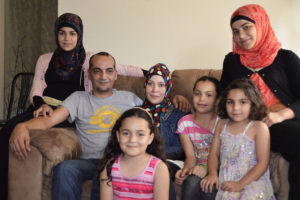The mathematics of improved refugee settlement
 The chances of newly resettled refugees finding work and settling successfully could be boosted by a new mathematical algorithm developed by researchers at Stanford University in the US.
The chances of newly resettled refugees finding work and settling successfully could be boosted by a new mathematical algorithm developed by researchers at Stanford University in the US.
The formula uses historical data on refugee resettlement to send new arrivals to locations where they are likely to thrive, rather than simply those with space to receive them.
The researchers from Stanford’s Immigration Policy Lab, used a machine learning algorithm to analyses historical data on refugee resettlement in the United States and Switzerland.
They found that the refugees’ eventual economic self-sufficiency depended on a combination of their individual characteristics, such as education level and knowledge of English, and where they were resettled within the country.
The researchers discovered that refugees with particular backgrounds or skills achieved better outcomes in some locations than others.
The algorithm assigned placements for refugees that they project would increase their chances of finding employment by roughly 40 to 70 percent compared with how the refugees actually fared, according to the study, published this month in the journal ‘Science’.
“As one looks at the refugee crisis globally, it’s clear that it’s not going away any time soon and that we need research-based policies to navigate through it,” said Professor Jeremy Weinstein, a co-author of the study.
“Our hope is to generate a policy conversation about the processes governing the resettlement of refugees, not just on the national level in the United States but internationally as well,” he said.
The researchers said the algorithm, which could be implemented at virtually no cost, could help resource-constrained governments and resettlement agencies find the best places for refugees to relocate.
In recent years, a record number of people have been displaced as a result of war, persecution and other human rights violations, surpassing the numbers seen after World War II. In 2016 alone, about 65.6 million people were forced to flee their homes, according to the UNHCR.
Often, countries that resettle refugees in their communities do so either somewhat randomly or according to local capacity of hosting communities at the time of refugees’ arrival.
The researchers said that in the United States, refugees who have family members at a particular location are directed to join them there.
But refugees without preexisting ties are free to be sent to various locations, and current approaches do not match them to locations where the evidence suggests it would be easiest for them to integrate.
“Our motivation was to bring the best of cutting-edge social science to an area of high policy priority that needs innovation but, because of the limited resources and challenges of navigating large numbers, has not been able to innovate from within,” Prof Weinstein said.
The group developed their algorithm based on socioeconomic data from more than 30,000 refugees, aged 18 to 64, placed by a major resettlement agency from 2011 to 2016 in the United States. The data also included where those refugees were resettled, and their eventual employment status.
Laurie Nowell
AMES Australia Senior Journalist












